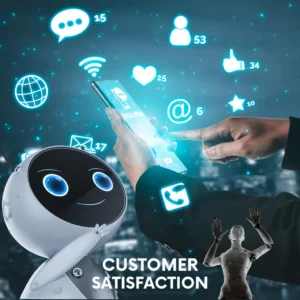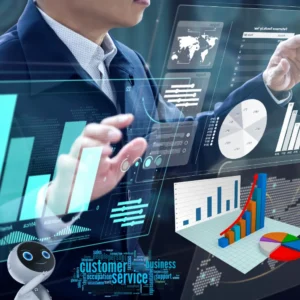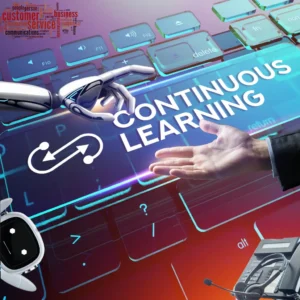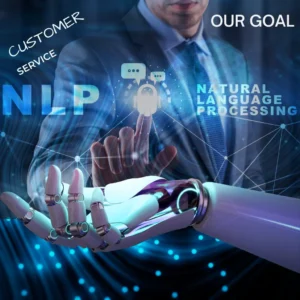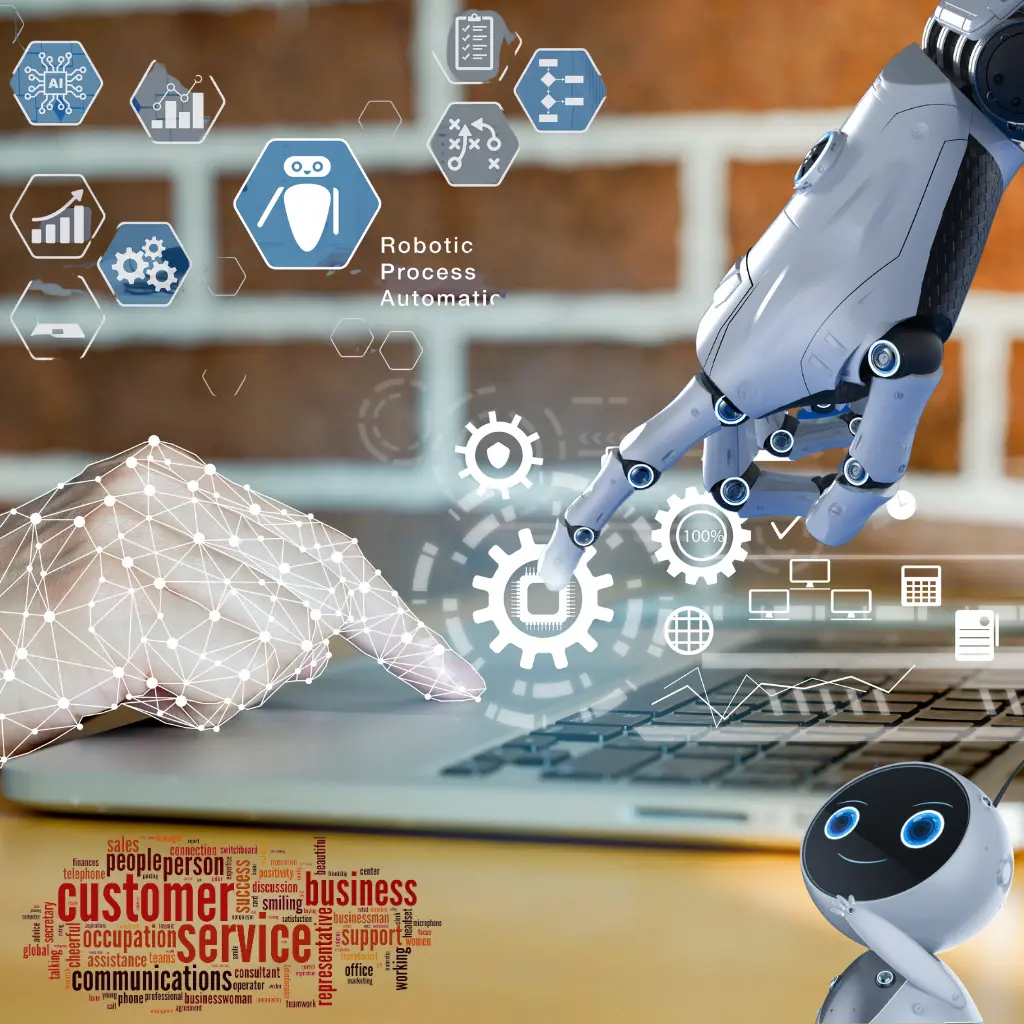
Revolutionizing Customer Service
Unleashing the Power of Automation and RPA Tools for a Seamless Experience
In the dynamic landscape of customer service, where efficiency and innovation are paramount, our company, with a steadfast 15-year presence in the domain, is strategically poised to harness the transformative capabilities of Customer Service Automation and Robotic Process Automation (RPA) Tools.
Focused on automating processes and incorporating cutting-edge AI technologies, our objective is to streamline routine tasks and elevate the overall customer experience.
From intelligent workflow automation to AI-driven follow-ups and automated order fulfilment, our discussion delves into the indispensable business and software knowledge, hardware prerequisites, training imperatives, and integrations required to integrate these tools successfully.
By exploring existing market leaders and presenting a comprehensive recommendation, we aim to navigate the intricate terrain of adopting RPA tools, ultimately positioning our company as a pioneering force in Customer Service Automation and Robotic Process Automation (RPA) Tools.
Table of Contents

Arindam Roy
An Automation Consultant with 25+ years of IT Experience
5 Automation and Robotic Process Automation (RPA) Tool ideas for the Customer Service
Customer Service Automation and Robotic Process Automation (RPA) Tools represent a cutting-edge suite of solutions designed to revolutionize customer service operations by leveraging advanced technologies. These tools aim to enhance efficiency, reduce manual efforts, and ensure timely resolution of customer issues.
1. Automated Ticket Resolution System:
This tool harnesses the power of Customer Service Automation and Robotic Process Automation (RPA) to streamline the resolution of common customer issues. By automating interactions with backend systems, the Automated Ticket Resolution System ensures swift and accurate responses to frequently encountered problems. This expedites query resolution and frees human resources to focus on more complex customer concerns.
2. RPA for Repetitive Task Automation:
Focused on automating repetitive and mundane tasks in customer service using Robotic Process Automation (RPA) for better efficiency. Automating repetitive tasks reduces manual effort, minimizes errors, and lets customer service reps focus on strategic activities.
3. Intelligent Workflow Automation:
In Customer Service Automation and RPA, Intelligent Workflow Automation takes centre stage. This tool utilizes AI algorithms to automate complex business processes and workflows intelligently. Understanding and adapting to dynamic scenarios ensures a seamless and efficient flow of tasks, ultimately enhancing the overall customer service experience. It is a sophisticated solution that evolves with changing business requirements.
4. Automated Follow-up on Customer Requests:
This tool employs AI-driven automation to follow up on customer requests proactively. Analyzing data and patterns ensures timely and personalized follow-ups, enhancing customer engagement and satisfaction. The system adapts to customer preferences and behaviours, providing a more tailored and responsive follow-up approach. This not only improves customer relations but also contributes to customer retention.
5. Process Automation for Order Fulfillment:
This tool optimizes the order processing and fulfilment tasks in the customer service pipeline within the scope of customer service automation and RPA. By applying RPA to these critical processes, the tool ensures accuracy, speed, and reliability in handling customer orders. This results in faster order processing, reduced errors, and improved end-to-end order fulfilment experience.
The Customer Service Automation and RPA Tools suite offers a comprehensive solution to transform traditional customer service operations. By integrating automation and AI technologies, these tools empower businesses to provide efficient, timely, and personalized service, positioning them as market leaders in the ever-evolving customer service landscape.
Automated ticket resolution system
Business Knowledge Required:
- Understanding of Customer Service Operations: A deep understanding of customer service processes, common customer issues, and resolution workflows is essential to designing effective automation solutions.
- Backend Systems Integration: Knowledge of the organization’s backend systems and how to seamlessly integrate the automated ticket resolution system with these systems is crucial.
- Compliance and Security Protocols: Familiarity with industry compliance standards and security protocols to ensure the automated processes adhere to legal and regulatory requirements.
Software Knowledge Needed:
- RPA Development Skills: Proficiency in RPA development tools and frameworks to create efficient and reliable automated processes for ticket resolution.
- API Integration Expertise: Knowledge of API integration to enable seamless communication between the automated system and backend systems, ensuring accurate issue resolution.
- User Interface (UI) Design: Skills in UI design to create user-friendly interfaces for customer service representatives interacting with the automated ticket resolution system.
Hardware Needed to Run the Tools:
- Sufficient Computing Resources: Adequate computing power to run the RPA tools efficiently, which may involve cloud-based solutions for scalability.
- Data Storage Infrastructure: Robust data storage infrastructure to store and retrieve customer data and interaction histories as needed during the resolution process.
Training Required to Run the Tools:
- User Training for System Interaction: Training for customer service representatives to effectively interact with and oversee the automated ticket resolution system, ensuring a smooth transition from manual to automated processes.
- Maintenance and Troubleshooting Training: To ensure that the automated tools run smoothly without interruption, IT support or maintenance teams must be trained to handle any issues and perform updates. The training should equip them with the necessary skills to maintain continuous and efficient operations.
Integrations Necessary:
- Customer Relationship Management (CRM) Systems: Integrate with CRM systems to access customer profiles, historical data, and relevant information. This helps us to provide accurate issue resolution.
- Backend System Integration: Seamless integration with backend systems where the automated system interacts to resolve customer issues, ensuring real-time updates and accuracy.
Comparative Tools Already Available in the Market:
- UiPath: A leading RPA platform that provides tools for automating various business processes, including customer service tasks.
- Blue Prism: Another popular RPA platform that offers capabilities for automating repetitive tasks and streamlining business processes.
Recommendation:
Given the maturity of existing RPA tools in the market, it is advisable to consider buying and customizing a proven RPA platform. The company can use established providers’ expertise while tailoring the tool to specific customer service needs in the context of Customer Service Automation and Robotic Process Automation (RPA) Tools.
Cost/Benefits Analysis on the Recommendation:
- Costs:
- Licensing Fees: Incurred costs for purchasing a subscription or licensing the chosen RPA platform.
- Customization Costs: Initial development costs for customizing the tool to align with specific customer service processes and workflows.
- Benefits:
- Time-to-Market: Faster implementation compared to building from scratch, leading to quicker efficiency gains in automated ticket resolution.
- Reliability and Support: Access to the reliability and support services provided by established RPA platform vendors, ensuring continuous operation and prompt issue resolution.
- Scalability: The scalability of existing RPA platforms allows the organization to adapt and expand automation efforts based on evolving customer service requirements.
In conclusion, the recommendation to buy and customize an existing RPA tool balances efficiency, reliability, and customization, making it a strategic choice for advancing Customer Service Automation and Robotic Process Automation (RPA) Tools.
RPA for repetitive task automation
Business Knowledge Required:
- Process Understanding: Identifying repetitive and manual tasks in existing customer service processes to automate for efficiency gains.
- Regulatory Compliance: Understanding regulatory frameworks related to customer service operations to ensure that the automated processes comply with industry standards.
- Employee Workflow Analysis: In-depth knowledge of how customer service representatives currently handle tasks, including the intricacies of repetitive tasks, to design seamless RPA solutions.
Software Knowledge Needed:
- RPA Development Skills: Proficiency in RPA development tools and platforms to design and implement automated solutions for repetitive tasks.
- Scripting Languages: Knowledge of scripting languages (like Python and JavaScript) for customizing and enhancing RPA scripts.
- Integration Platforms: Familiarity with integration platforms to connect RPA tools with existing systems and databases.
Hardware Needed to Run the Tools:
- Sufficient Computing Resources: Adequate computing power to run RPA tools efficiently, considering the scale of automation across various repetitive tasks.
- Data Storage Infrastructure: Robust data storage infrastructure to store relevant information and logs generated during the automation process.
Training Required to Run the Tools:
- RPA Operation Training: This involves training employees to operate and oversee the RPA tools, ensuring a smooth transition from manual to automated processes.
- Maintenance and Troubleshooting Training: IT support and maintenance teams undergo training to ensure the smooth operation of RPA tools, including issue resolution and updates.
Integrations Necessary:
- Integration with CRM Systems: Seamless integration with Customer Relationship Management (CRM) systems to access customer data and ensure that automated tasks align with customer service strategies.
- Data Source Integration: Integrating with relevant databases and data sources to gather information for task automation.
Comparative Tools Already Available in the Market:
- UiPath: A leading RPA platform known for its versatility in automating various business processes, including repetitive tasks in customer service.
- Automation Anywhere: This popular tool can automate tasks, streamline processes, and improve operational efficiency. It makes work easier and faster.
Recommendation:
Given the availability of mature and versatile RPA tools in the market, it is recommended that you buy and customize an existing RPA platform. This approach allows the company to benefit from the expertise of established providers while tailoring the tool to specific customer service needs within the context of Customer Service Automation and Robotic Process Automation (RPA) Tools.
Cost/Benefits Analysis on the Recommendation:
- Costs:
- Licensing Fees: Incurred costs for purchasing a subscription or licensing the chosen RPA platform.
- Customization Costs: Initial development costs for customizing the tool to align with specific customer service processes and workflows.
- Benefits:
- Time-to-Market: Faster implementation compared to building from scratch, leading to quicker efficiency gains in repetitive task automation.
- Reliability and Support: Access to the reliability and support services provided by established RPA platform vendors, ensuring continuous operation and prompt issue resolution.
- Scalability: The scalability of existing RPA platforms allows the organization to adapt and expand automation efforts based on evolving customer service requirements.
In conclusion, the recommendation to buy and customize an existing RPA tool balances efficiency, reliability, and customization, making it a strategic choice for advancing Customer Service Automation and Robotic Process Automation (RPA) Tools.
Intelligent workflow automation
Business Knowledge Required:
- Business Process Understanding: In-depth knowledge of existing business processes and workflows within customer service operations, including complexities and variations.
- AI and Machine Learning Concepts: A solid understanding of AI and machine learning concepts is essential for effectively leveraging these technologies for intelligent automation.
- Customer Interaction Analysis: Insight into customer interactions and service touchpoints to identify opportunities for intelligent workflow automation that enhances customer experiences.
Software Knowledge Needed:
- AI and Machine Learning Development: Proficiency in AI and machine learning development tools and frameworks to implement intelligent algorithms for process automation.
- Workflow Automation Platforms: Knowledge of workflow automation platforms to seamlessly design and orchestrate complex business processes.
- Integration Technologies: Familiarity with integration technologies to connect the intelligent workflow automation tool with other systems and databases.
Hardware Needed to Run the Tools:
- Sufficient Computing Resources: Adequate computing power, potentially leveraging cloud services, to handle the computational demands of running AI algorithms for real-time workflow automation.
- Data Storage Infrastructure: Robust data storage infrastructure to store and retrieve relevant information while executing complex workflows.
Training Required to Run the Tools:
- AI and ML Operation Training: Training employees to operate and oversee the intelligent workflow automation tool, including understanding AI-driven decision-making processes.
- Maintenance and Troubleshooting Training: Training for IT support or maintenance teams to address any issues, perform updates, and ensure the operation of the intelligent automation tool.
Integrations Necessary:
- Customer Relationship Management (CRM) Systems: Integrate with CRM systems to access customer profiles, history, and other relevant data for intelligent workflow decision-making.
- Data Source Integration: Integrating with relevant databases and data sources to gather information needed for the dynamic and intelligent execution of workflows.
Comparative Tools Already Available in the Market:
- Pega Systems: Offers an AI-powered platform for business process automation, providing capabilities for intelligent decision-making within workflows.
- Appian: Another platform that combines business process management and AI to automate workflows intelligently.
Recommendation:
Considering the sophistication and specialization required for intelligent workflow automation, it is recommended that you buy and customize an existing platform. This approach allows the company to benefit from the expertise of established providers while tailoring the tool to specific customer service needs within the context of Customer Service Automation and Robotic Process Automation (RPA) Tools.
Cost/Benefits Analysis on the Recommendation:
- Costs:
- Licensing Fees: Incurred costs for purchasing a subscription or licensing the chosen intelligent workflow automation platform.
- Customization Costs: Initial development costs for customizing the tool to align with specific customer service processes and workflows.
- Benefits:
- Time-to-Market: Faster implementation compared to building from scratch, leading to quicker efficiency gains in intelligent workflow automation.
- Expertise Access: Access to the specialized expertise of established providers, ensuring the accuracy and reliability of AI-driven decision-making within workflows.
- Scalability: The scalability of existing platforms allows the organization to adapt and expand automation efforts based on evolving customer service requirements.
In conclusion, we recommend purchasing and customizing an existing intelligent workflow automation tool that balances efficiency, accuracy, and customization within the context of Customer Service Automation and Robotic Process Automation (RPA) tools.
Automated follow-up on customer requests
Business Knowledge Required:
- Customer Service Workflows: In-depth understanding of customer service workflows, including the various stages of customer request handling, resolution processes, and potential bottlenecks.
- Customer Communication Strategies: Knowledge of effective communication strategies to ensure that AI-driven follow-up messages align with the brand voice and maintain positive customer interactions.
- Service Level Agreements (SLAs): Familiarity with SLAs and time-sensitive requirements to implement timely follow-up automation to customer expectations.
Software Knowledge Needed:
- Natural Language Processing (NLP): Proficiency in NLP to enable the system to understand and generate natural-sounding follow-up messages based on customer requests.
- Machine Learning for Predictive Analytics: Understanding machine learning concepts for predicting optimal follow-up times and dynamically adjusting the follow-up strategies based on historical data.
- Automation Scripting and Workflow Tools: Skills in automation scripting and workflow tools to seamlessly design and implement automated follow-up processes.
Hardware Needed to Run the Tools:
- Sufficient Computing Resources: Adequate computing power, potentially leveraging cloud services, to handle the computational demands of running AI algorithms for natural language processing and machine learning.
- Data Storage Infrastructure: Robust data storage infrastructure to store customer interaction history and relevant data for personalized and context-aware follow-ups.
Training Required to Run the Tools:
- User Training for Monitoring: Customer service representatives will be trained to monitor and oversee the AI-driven automated follow-up processes, ensuring they align with the company’s customer service goals.
- Adaptation Training for AI Enhancements: Training for teams responsible for adapting and improving the AI algorithms based on feedback and changing customer service dynamics.
Integrations Necessary:
- Customer Relationship Management (CRM) Systems: Integration with CRM systems to access customer profiles, interaction history, and other relevant data for personalized and effective follow-ups.
- Communication Platforms: Integration with communication platforms (email, messaging systems) to deliver automated follow-up messages to customers.
Comparative Tools Already Available in the Market:
- Zendesk: Offers automated follow-up capabilities within its customer service platform, including ticket status updates and resolution confirmations.
- Freshdesk: Provides automation features for follow-up communications, ensuring timely responses and resolutions to customer requests.
Recommendation:
Given the available tools in the market and the need for specialized capabilities in automated follow-ups, buying and customizing an existing tool is recommended. This approach allows the leveraging of the expertise of established providers while tailoring the tool to specific customer service needs within the context of Customer Service Automation and Robotic Process Automation (RPA) Tools.
Cost/Benefits Analysis on the Recommendation:
- Costs:
- Licensing Fees: Incurred costs for purchasing a subscription or licensing the chosen automated follow-up platform.
- Customization Costs: Initial development costs for customizing the tool to align with specific customer service processes and communication strategies.
- Benefits:
- Time-to-Market: Faster implementation compared to building from scratch, leading to quicker efficiency gains in automated follow-up processes.
- Scalability: The scalability of existing platforms allows the organization to adapt and expand automation efforts based on evolving customer service requirements.
- User Adoption: Easier user adoption as employees are already familiar with the functionalities of established automated follow-up platforms.
In conclusion, the recommendation to buy and customize an existing automated follow-up tool balances efficiency, reliability, and customization within the context of Customer Service Automation and Robotic Process Automation (RPA) Tools.
Process automation for order fulfilment
Business Knowledge Required:
- Order Fulfillment Processes: In-depth knowledge of the end-to-end order fulfilment processes, including order processing, inventory management, and shipping logistics within the customer service pipeline.
- Regulatory Compliance: Understanding of industry regulations related to order processing and fulfilment to ensure that the automated processes adhere to legal and compliance standards.
- Supply Chain Dynamics: Familiarity with supply chain dynamics and vendor relationships to optimize order fulfilment processes efficiently.
Software Knowledge Needed:
- RPA Development Skills: Proficiency in RPA development tools and frameworks to design, develop, and deploy automation scripts for order processing and fulfilment tasks.
- Integration Technologies: Knowledge of integration technologies to connect RPA tools with other systems, such as inventory management, payment gateways, and shipping providers.
- Data Processing and Analysis: Skills in data processing and analysis tools to extract insights from order data and optimize the automation processes continuously.
Hardware Needed to Run the Tools:
- Sufficient Computing Resources: Adequate computing power, potentially leveraging cloud services, to handle the computational demands of running RPA scripts for order fulfilment.
- Data Storage Infrastructure: Robust data storage infrastructure to store and retrieve order data, transaction histories, and other relevant information during the fulfilment process.
Training Required to Run the Tools:
- RPA Operation Training: Training employees to operate and monitor the RPA tools responsible for order fulfilment, ensuring smooth execution and issue resolution.
- Continuous Improvement Training: Training teams to adapt and enhance the RPA scripts based on evolving customer service requirements and changes in the order fulfilment process.
Integrations Necessary:
- Inventory Management Systems: Integrate with inventory management systems to synchronize real-time stock levels and prevent order processing for out-of-stock items.
- Payment Gateways: Integration with payment gateways for seamless and secure transaction processing during order fulfilment.
- Shipping Providers: Integration with shipping providers to automate the generation of shipping labels, track orders, and ensure timely delivery.
Comparative Tools Already Available in the Market:
- Blue Prism: A popular RPA tool known for its versatility in automating various business processes, including order fulfilment tasks.
- UiPath: Another leading RPA platform offering capabilities for end-to-end process automation, including order processing and fulfilment.
Recommendation:
Considering the complexity and specificity of order fulfilment processes, buying and customizing an existing RPA platform is recommended. This approach allows the company to benefit from the expertise of established providers while tailoring the tool to specific customer service needs within the context of Customer Service Automation and Robotic Process Automation (RPA) Tools.
Cost/Benefits Analysis on the Recommendation:
- Costs:
- Licensing Fees: Incurred costs for purchasing a subscription or licensing the chosen RPA platform.
- Customization Costs: Initial development costs for customizing the tool to align with specific order fulfilment processes and workflows.
- Benefits:
- Time-to-Market: Faster implementation compared to building from scratch, leading to quicker efficiency gains in automated order fulfilment.
- Expertise Access: Access to the specialized expertise of established RPA platform vendors, ensuring the accuracy and reliability of order fulfilment automation.
- Scalability: The scalability of existing RPA platforms allows the organization to adapt and expand automation efforts based on evolving customer service requirements.
In conclusion, the recommendation to buy and customize an existing RPA tool balances efficiency, reliability, and customization within the context of Customer Service Automation and Robotic Process Automation (RPA) Tools.
Conclusion
In conclusion, the journey towards leveraging Customer Service Automation and Robotic Process Automation (RPA) Tools represents a strategic move for our company, with a rich 15-year history in the customer service domain. The comprehensive suite of tools envisioned, from automated ticket resolution systems to intelligent workflow automation and AI-driven follow-ups, is poised to revolutionize our operational landscape.
The success of these initiatives hinges on a fusion of profound business insights and cutting-edge software expertise. An intimate understanding of customer service workflows, communication strategies, and regulatory landscapes is paramount for crafting tools that automate and enhance the customer experience. Equally crucial is a robust grasp of RPA development, AI, and machine learning, ensuring the seamless integration of technologies to streamline processes.
While the theoretical foundations are vital, the practical implementation relies on scalable computing resources, data storage infrastructure, and strategic integrations with CRM systems and communication platforms. The training imperative cannot be overstated, emphasizing the need for teams versed in operating these tools and adapting them to evolving customer service dynamics.
Exploring existing market leaders like UiPath and Blue Prism, a prudent recommendation emerges: buying and customizing proven RPA platforms. This approach capitalizes on the expertise of established providers, expediting the time-to-market, ensuring reliability, and allowing scalability. The cost/benefits analysis underscores the efficiency gains and adaptability advantages, making it a strategic decision in our pursuit of excellence in Customer Service Automation and Robotic Process Automation (RPA) Tools. Through this transformative journey, our commitment to innovation and customer-centric operations stands poised for elevation in the ever-evolving customer service landscape.
Related Articles
- 50 AI Tools for the Customer Services Domain
- 5 Facial Recognition and Emotion Analysis Tools of Customer Service
- 5 Customer Service Speech Recognition and Processing Tools
- 5 Customer Service Predictive Analytics and Recommendation
- 5 Customer Service Natural Language Processing (NLP) Tools
- 5 Customer Service Tools for Knowledge Management
- 5 Customer Service Tools for Continuous Learning and Improvement
- 5 Customer Service Tools for Customer Survey Analysis
- 5 Customer Service Tools for Social Media Monitoring
- 5 Customer Service Tools for Data Security and Privacy


